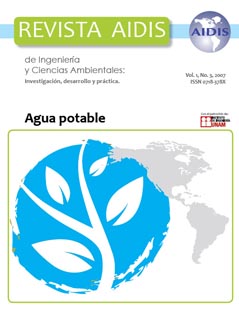Concentrations of arsenic that reach values of 2.35 mg L-1 have been identified in potable water sources in Mexico. Such concentration is above to the maximum permissible limit of 0.025 mg L-1 set by the Mexican Standard. It has been estimated that nearly
Main Article Content
Abstract
Concentrations of arsenic that reach values of 2.35 mg L-1 have been identified in potable water sources in Mexico. Such concentration is above to the maximum permissible limit of 0.025 mg L-1 set by the Mexican Standard. It has been estimated that nearly 500,000 people living in rural areas are exposed, through their water intake, to concentrations of arsenic in excess of 0.05 mg L-1. The objective of this study was to evaluate the removal of arsenic present in the water for human consumption in the town of Huautla, Morelos, Mexico using electrochemical technology. This technology was developed in Canada and it is based in the principle of capacitive deionization, as an electrostatic charging system formed by carbon electrodes. The electrodes are supplied with direct current (~1V, 0-375A), which produces surfaces with positive and negative charge. The ionic compounds that contain arsenic are thus electrostatically adsorbed onto the electrodes, and the water obtained reached concentrations below 0.005 mg L-1 as total arsenic. The average percentage of arsenic removal was 98.51% and the volume of reject water was 3%. The results of this study indicate that this technology is more efficient an potentially more economical than conventional technologies.
Article Details
How to Cite
[1]
Garrido Hoyos, S.E., Avilés Flores, M., Ramírez González, A., Calderón Mólgora, C. and Nieto Rodríguez, A. 2009. Concentrations of arsenic that reach values of 2.35 mg L-1 have been identified in potable water sources in Mexico. Such concentration is above to the maximum permissible limit of 0.025 mg L-1 set by the Mexican Standard. It has been estimated that nearly. Revista AIDIS de ingeniería y ciencias ambientales: Investigación, desarrollo y práctica. 1, 3 (Nov. 2009).
